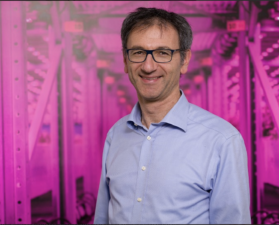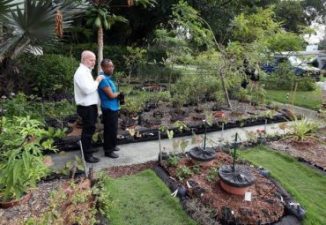 It’s coming up on two years since Cameron Sinclair announced the shutdown of Architecture for Humanity, probably the best thing to ever emerge from an architect’s imagination. That San Francisco-based nonprofit brought pro-bono architecture to the world’s neediest communities. Now a young husband/wife team have stepped into the void, launching a venture to make affordable, ecological housing accessible to everyone.
It’s coming up on two years since Cameron Sinclair announced the shutdown of Architecture for Humanity, probably the best thing to ever emerge from an architect’s imagination. That San Francisco-based nonprofit brought pro-bono architecture to the world’s neediest communities. Now a young husband/wife team have stepped into the void, launching a venture to make affordable, ecological housing accessible to everyone.
Ever see an Amish barn-raising? It’s a human ant farm of activity wherein a collective of people meet for a limited time to rapidly erect a pre-planned building. Open Source Ecology (OSE) and Open Building Institute (OBI) have joined forces in a project that enables aspiring homeowners to do the same, anywhere.
Their project integrates open source hardware with ecofriendly modular design. A library of designs and rapid-build procedures allows users to build a 700 square foot “Expandable Starter Home” that costs about a tenth of what a typical new home would set you back. The basic design is energy-efficient and off-grid.
It’s loaded with ecological features, including an option for an aquaponic greenhouse which can produce all the fish and vegetables that a family needs. Build it all from raw materials in five days. And that “starter” building can easily be expanded based on user requirements.
 The Open Building Institute aims to make affordable housing widely available while fostering collaborative and ecological best practices. They offer a free catalog of building modules, including walls, windows, doors, roof, and utilities that can be combined to create studios, homes, multi-family houses, greenhouses, barns, workshops, schools, and offices.
The Open Building Institute aims to make affordable housing widely available while fostering collaborative and ecological best practices. They offer a free catalog of building modules, including walls, windows, doors, roof, and utilities that can be combined to create studios, homes, multi-family houses, greenhouses, barns, workshops, schools, and offices.
OBI was co-founded by Catarina Mota and Marcin Jakubowski. She holds a Ph. D. in communication sciences and her research work focuses on the social impact of open and collaborative practices developing technologies. She is a founding member the Open Source Hardware Association and a TED fellow. He holds a Ph. D. in fusion physics, and has been called an Innovation Stuntman, a Disruptive Hero, and a 2013 White House Champion of Change. He is also a TED fellow.
Jakubowski (MJ) sat down for a question and answer session with writer Cat Johnson (CJ). Excerpts from that interview – shared with Green Prophet by Jakubowski – follow:
 CJ: How did the Open Building Institute (OBI) come about? What need does it fill that is not available elsewhere?
CJ: How did the Open Building Institute (OBI) come about? What need does it fill that is not available elsewhere?
MJ: My wife and I married in 2013 and moved from Brooklyn to the middle of nowhere – Missouri. She realized that our house we was simply too small. We called contractors, but found that what we wanted didn’t exist. We needed a comfortable house that didn’t cost a million dollars, that could be built quickly from local materials, and that could be expanded as we grow.
There was only one option: build it ourselves. So we did. We examined best practices then took our open source high power brick press and, through trial and error, developed a formula for rapid builds. With rapid builds, a big group of people builds a large number of modules in parallel and then assembles them rapidly into a building. We realized that, using these techniques, we could build an 800 square foot structure from scratch in just five days. So we decided to take it to the next level.
For a few years now we’ve been developing an open source toolkit that can make building a house easier, faster, and cheaper. We started a library of modules that can be put together like building blocks. We’re developing instructionals, including software and other tools to enable anyone to design and build using this system. Moreover, we’re creating a training program for our system so you can hire an OBI builder anywhere in the world.
We decided to build a solar-powered, replicable Materials Production Facility so you can use local materials wherever you are. Focusing on integrated, regenerative design, we are pursuing Living Building Challenge certification, which is the highest standard for regenerative construction. We are also developing a social model of production, where apprentices-in-training build the houses during immersion training workshops. Our combination of rapid build time, low-cost, regenerative features, user-generated design, and feasibility of both social production or commercial build models are not found in any other house offering. Our value proposition revolves around democratizing construction.
 Why does open, low-cost, modular building make sense?
Why does open, low-cost, modular building make sense?
Because you can design and modify it yourself for your specific needs—or you can use existing designs. Open design means full access to use, distribute, modify, or sell the product, free of charge. Low cost makes sense, and modular housing can be built in an incremental fashion. Our standard model costs under $25,000 for materials for a 700 square foot, expandable Starter Home. But you can build a structure of any size.
The point of modular design is that you have access to design assets that have already been engineered in detail by others so you are able to create house designs that are fanciful, but also buildable. If you contribute your designs back to the common pool under a share-alike license (a requirement of using the OBI library) then access to quality designs increases with time. The whole ecosystem grows in value and service to humanity.
 What type of designs are found in the library and why is the collaborative and distributed approach important?
What type of designs are found in the library and why is the collaborative and distributed approach important?
The library now has around 20 structure and utility modules that we have built and tested over the last three years. The library includes materials, build processes, structural and utility modules, and entire house designs. June 29 marked the official launch of OBI. We will start accepting contributions to the library from the public as soon as we reach our funding goal. As people contribute and the library grows, the more valuable the system becomes.
 Open source means that everyone is free to use, modify and redistribute the designs. How do you see the open source movement intersecting with the affordable, ecological housing movement?
Open source means that everyone is free to use, modify and redistribute the designs. How do you see the open source movement intersecting with the affordable, ecological housing movement?
Open source also means that you can learn more about building and get actively involved, as opposed to leaving it to others and accepting their choices without fully understanding them. This is important, since involved, knowledgeable, proactive citizens are the only thing that can change the world.
Open source means that innovation is unleashed. We are pursuing the extreme limit of both ecology and cost, as exemplified in our goal of attaining Living Building Challenge compliance while remaining affordable.
 There’s a focus on empowering non-professional builders with modules that can be easily and quickly built. Why is this important? Who do you see utilizing the library and Institute?
There’s a focus on empowering non-professional builders with modules that can be easily and quickly built. Why is this important? Who do you see utilizing the library and Institute?
Empowering non-professionals to build increases access to housing as more people become able to build and to do so at lower cost. This is especially relevant with the tide of urbanization. It’s estimated that by 2030, out of the five billion people living in cities, two billion will be below the poverty line. This can be solved by incremental housing…only if we channel people’s own building capacity. We envision that DIY builders and startup entrepreneurs will be our early adopters and that some of our designs will be adopted by mainstream builders once the open source cost-to-performance advantage becomes clear.
 Who contributed designs and are the designs tested or approved?
Who contributed designs and are the designs tested or approved?
The current designs have been produced by Catarina Mota, project founder (shown with Jakubowski, below). We aim to have modules, materials, and house designs fully certified, with calculations and engineering approvals – including code compliance.
We will offer support in navigating building codes, and we will crowdsource location-based information on standards and requirements for locations around the world. We will encourage voluntary contributions of not only on module designs, but also on materials testing, product certification, code compliance, and engineering calculations. We will document testing protocols so that our products have an extra layer of transparency.
 If everything goes well, what would you most like to see?
If everything goes well, what would you most like to see?
The average American pays $1.2 MIL over their lifetime just to secure their home. And 1.6 BIL people live without adequate housing. Housing is a basic need. We envision a world where everyone has access to housing without getting into debt; a future where regenerative housing helps to heal the environment by providing surplus food, energy, and fuel to its inhabitants; a world where housing contributes to the natural ecology of a place.
~~~~~~~~~~~~~~~~~~~~~~~~~~~~~~~~~~~~~~~~~~~~~~~~~~~~~~~~~~~~~~~~~~~~~~~~~~~~~~~~~~~~~~~
The project launched this year, after a Kickstarter campaign successfully raised $115,860 with 1,902 backers. OBI plans to roll out a turnkey construction service in 2017. The project also aims to achieve Living Building Challenge certification next year, which is the highest standard for eco-construction.
The Open Building Institute is the culmination of several years of experiments building ecological, affordable housing at the couple’s farm in Missouri, USA. Their toolkit is open source and available free of charge—forever, with no exceptions—and includes a library of modular designs, instructionals, software, and open source machines (for construction and production of building materials). Users can also contribute designs to the project through the OBI Design Challenge.
Learn more at the OBI website (link here) where you can contribute ideas, and cash, to support the project. Open Source Ecology is developing the Global Village Construction Set which are 50 industrial machines for building civilization from scratch.
Watch Jakubowski’s 2011 Ted Talk on “Open Source Blueprints for Civilization”, link here. Then watch OBI change the world. Or better yet, help them do it.
Images from OBI



